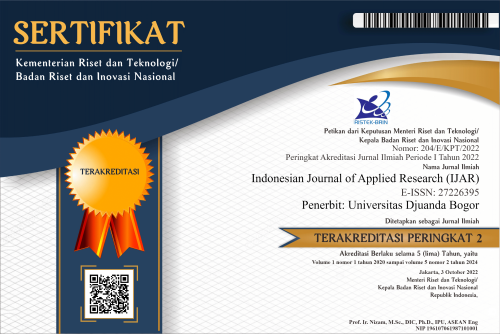Application of Cooperative Learning Model for Mathematics in Elementary School
Abstract
n the process of teaching and learning it will be fun if students have self-efficacy and the teacher has high creativity in teaching. The purpose of this study is to find out how much the relationship between teacher teaching creativity and self-efficacy of fifth grade students at SDN Sukamaju 03 District Cigudeg, Bogor Regency. This type of quantitative research is a functional relationship between variable X with variable Y, the subjects in this study were 1 group teacher that was sampled only grade V teachers who numbered 20 and class V students of SDN Sukamaju 03 totaling 20 students and the data obtained from questionnaires, Data collection techniques by questionnaire, observation, interview and documentation. Based on the results of testing using product moment, the correlation between teacher teaching creativity (X) with student self-efficacy (Y) obtained a value of rcount = 0.790 and rtable for 20 is 0.444 at level significance of 5% thus rcount > rtable (0.790> 0.444) then H0 is rejected, which means there is a significant correlation between creativity teaching self-efficacy of teachers with students. The significance of the regression equation obtained the Fcount of 29.840 and the Ftable of 4.41 with a sig value of 0.000, so that Fcount > Ftable, then there is a significant relationship between teacher teaching creativity (Variable X) and student self-efficacy (Variable Y). And this research is to get R2 = 0.624 62.4% showed their creativity variables affect self-efficacy of teachers to teach students, the remaining 37.6% influenced by other factors not an analysis in this study.
The Authors submitting a manuscript do so on the understanding that if accepted for publication, copyright publishing of the article shall be assigned/transferred to Indonesian Journal of Applied Research (IJAR) Universitas Djuanda as Publisher of the journal. Upon acceptance of an article, authors will be asked to complete a 'Copyright Transfer Agreement'. An e-mail will be sent to the corresponding author confirming receipt of the manuscript together with a 'Copyright Transfer Agreement' form by online version of this agreement.
Indonesian Journal of Applied Research (IJAR) Universitas Djuanda, the Editors and the Editorial Board make every effort to ensure that no wrong or misleading data, opinions or statements be published in the journal. In any way, the contents of the articles and advertisements published in the Indonesian Journal of Applied Research (IJAR) Universitas Djuanda are sole and exclusive responsibility of their respective authors and advertisers.
Remember, even though we ask for a transfer of copyright, our journal authors retain (or are granted back) significant scholarly rights as mention before.
The Copyright Transfer Agreement (CTA) Form can be downloaded here: Copyright Transfer Agreement-IJAR 2020
The copyright form should be signed electronically and send to the Editorial Office e-mail below:
Prof. Dr. Ir. Dede Kardaya, M.Si. (Editor-in-Chief)
Universitas Djuanda
Jl. Tol Jagorawi No.1, Ciawi, Kec. Ciawi, Bogor, Jawa Barat 16720
Website: http://journal.unida.ac.id/index.php/IJAR/index
Email: ijar@unida.ac.id






 This work is licensed under a
This work is licensed under a 